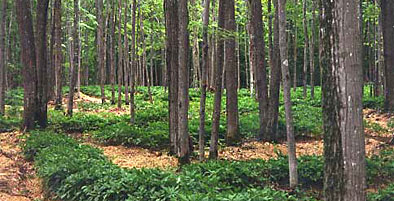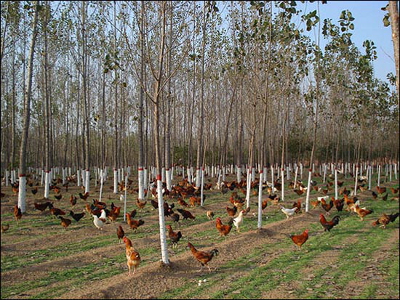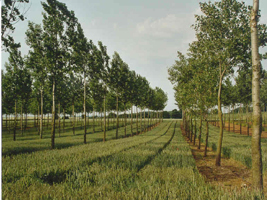
USDA-approved agroforestry
 The last tidbit I mined out of Restoration Agriculture
was really a venue for further exploration. Shepard explained
that the USDA has five officially-sanctioned types of agroforestry,
which means we can hunt down scientific studies on each of these topics
to give us jumping-off points for our own explorations. The first
two --- wind breaks and riparian buffers --- are self-explanatory and
are more about protecting the rest of the farm and ecosystem than they
are about growing food, but the others have food potential.
The last tidbit I mined out of Restoration Agriculture
was really a venue for further exploration. Shepard explained
that the USDA has five officially-sanctioned types of agroforestry,
which means we can hunt down scientific studies on each of these topics
to give us jumping-off points for our own explorations. The first
two --- wind breaks and riparian buffers --- are self-explanatory and
are more about protecting the rest of the farm and ecosystem than they
are about growing food, but the others have food potential.
Despite the name, forest
farming (as defined by the USDA) isn't the same as forest gardening (as
defined by the permaculture community). This is a closed-forest
type of setting with shade-tolerant plants including medicinal herbs
(ginseng, etc.), ramps, gooseberries, currants, and edible mushrooms
grown underneath the trees. I feel like this form of agroforestry
is most useful for folks who need a cash crop, less so for trying to
feed ourselves.

Silvopastures are a concept I've written about here before (and which have informed my own pasture experiments).
The idea is to combine trees and pasture, with the aim of producing 40
to 60% canopy coverage. An easy way to start a silvopasture is to
plant trees along permanent fencelines, focusing primarily on
deep-rooted species so they don't compete too much with the grass.
Fruit trees, pecans, walnuts, hickories, chestnuts, and pines have all
been used in official studies.
 The
final type of USDA-approved agroforestry is alley cropping, with rows
of trees separated by annual field crops. The trees are often
oaks, walnuts, or pecans, and the trick (again) is to keep the trees'
roots from competing with the annual crops. Since most people are
plowing their annual crop fields, they generally use a subsoiler each
year as well to cut back tree roots that are trying to invade the main
fields, tempting the trees' roots instead to dig deep.
The
final type of USDA-approved agroforestry is alley cropping, with rows
of trees separated by annual field crops. The trees are often
oaks, walnuts, or pecans, and the trick (again) is to keep the trees'
roots from competing with the annual crops. Since most people are
plowing their annual crop fields, they generally use a subsoiler each
year as well to cut back tree roots that are trying to invade the main
fields, tempting the trees' roots instead to dig deep.
If you're trying to
create your own perennial-based system like I am, I highly recommend
checking out extension-service documents about these various
agroforestry systems online. It's always a good idea to know
what's been tried before you go out to reinvent the wheel.
| This post is part of our Restoration Agriculture lunchtime series.
Read all of the entries: |
Want more in-depth information? Browse through our books.
Or explore more posts by date or by subject.
About us: Anna Hess and Mark Hamilton spent over a decade living self-sufficiently in the mountains of Virginia before moving north to start over from scratch in the foothills of Ohio. They've experimented with permaculture, no-till gardening, trailersteading, home-based microbusinesses and much more, writing about their adventures in both blogs and books.
Want to be notified when new comments are posted on this page? Click on the RSS button after you add a comment to subscribe to the comment feed, or simply check the box beside "email replies to me" while writing your comment.
